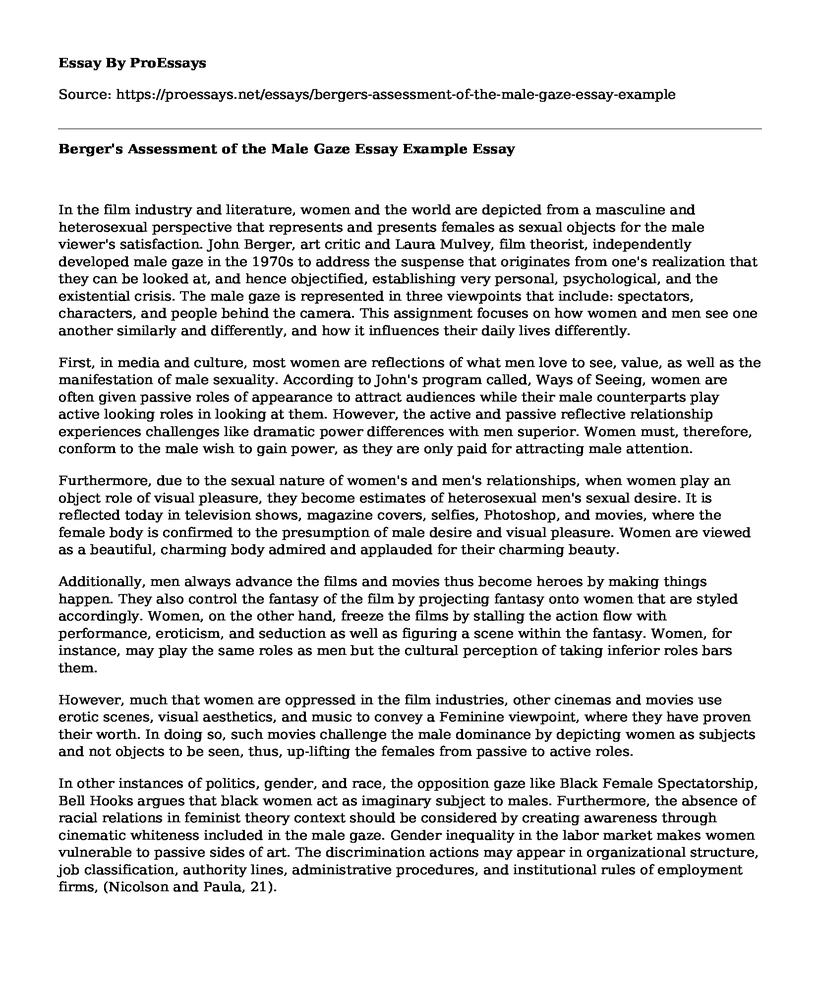In the film industry and literature, women and the world are depicted from a masculine and heterosexual perspective that represents and presents females as sexual objects for the male viewer's satisfaction. John Berger, art critic and Laura Mulvey, film theorist, independently developed male gaze in the 1970s to address the suspense that originates from one's realization that they can be looked at, and hence objectified, establishing very personal, psychological, and the existential crisis. The male gaze is represented in three viewpoints that include: spectators, characters, and people behind the camera. This assignment focuses on how women and men see one another similarly and differently, and how it influences their daily lives differently.
First, in media and culture, most women are reflections of what men love to see, value, as well as the manifestation of male sexuality. According to John's program called, Ways of Seeing, women are often given passive roles of appearance to attract audiences while their male counterparts play active looking roles in looking at them. However, the active and passive reflective relationship experiences challenges like dramatic power differences with men superior. Women must, therefore, conform to the male wish to gain power, as they are only paid for attracting male attention.
Furthermore, due to the sexual nature of women's and men's relationships, when women play an object role of visual pleasure, they become estimates of heterosexual men's sexual desire. It is reflected today in television shows, magazine covers, selfies, Photoshop, and movies, where the female body is confirmed to the presumption of male desire and visual pleasure. Women are viewed as a beautiful, charming body admired and applauded for their charming beauty.
Additionally, men always advance the films and movies thus become heroes by making things happen. They also control the fantasy of the film by projecting fantasy onto women that are styled accordingly. Women, on the other hand, freeze the films by stalling the action flow with performance, eroticism, and seduction as well as figuring a scene within the fantasy. Women, for instance, may play the same roles as men but the cultural perception of taking inferior roles bars them.
However, much that women are oppressed in the film industries, other cinemas and movies use erotic scenes, visual aesthetics, and music to convey a Feminine viewpoint, where they have proven their worth. In doing so, such movies challenge the male dominance by depicting women as subjects and not objects to be seen, thus, up-lifting the females from passive to active roles.
In other instances of politics, gender, and race, the opposition gaze like Black Female Spectatorship, Bell Hooks argues that black women act as imaginary subject to males. Furthermore, the absence of racial relations in feminist theory context should be considered by creating awareness through cinematic whiteness included in the male gaze. Gender inequality in the labor market makes women vulnerable to passive sides of art. The discrimination actions may appear in organizational structure, job classification, authority lines, administrative procedures, and institutional rules of employment firms, (Nicolson and Paula, 21).
Conclusion
In conclusion, with the evolution of concepts in the art industry and within the gaze, perspective can be obtained in approach to interaction with such jobs. Additionally, the sociopolitical context may be applied to bolster perspective on the lives of artists, dancers, and everyone's own perception. The depth of interaction may also create awareness on the positive value that needs to be championed as well as distorting the negative structures that subvert the value of other artists.
Work cited
Nicolson, Paula. Gender, Power and Organization: A psychological perspective on life at work. Routledge, 2015.
Cite this page
Berger's Assessment of the Male Gaze Essay Example. (2022, Sep 05). Retrieved from https://proessays.net/essays/bergers-assessment-of-the-male-gaze-essay-example
If you are the original author of this essay and no longer wish to have it published on the ProEssays website, please click below to request its removal:
- The Importance of Parenting Styles: Essay Sample
- Essay Example on African Americans and Criminal Justice: Unequal Representation and Its Impact
- The Foundation of Social Facts: Understanding Social Norms and Expectations - Essay Sample
- Effective Communication: Verbal & Non-Verbal - Research Paper
- The Acorn of Self-Belief: Unlocking Your Potential - Essay Sample
- Adolescents: Becoming Violent in the Transition to Adulthood - Essay Sample
- Essay Example on Class Conflict in Modern Society: An Analysis of Dahrendorf's Theory







